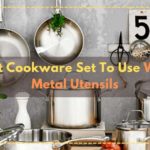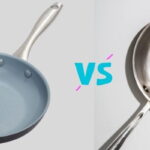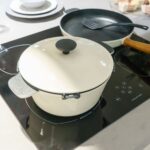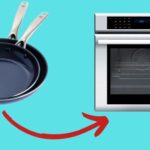14 Pros and Cons of Hard Anodized Cookware you need to know about
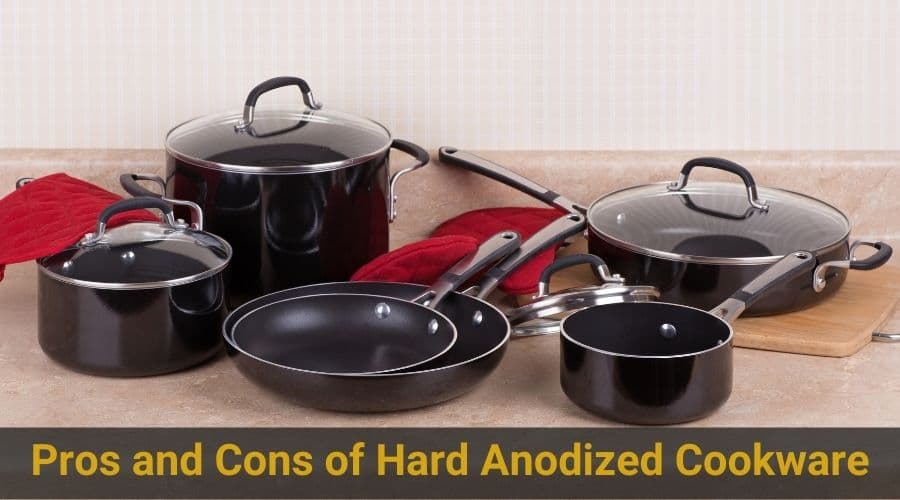
Hard anodized cookware is a type of nonstick cookware that uses aluminum as its base. Aluminum can scratch or dent easily and this makes it unsuitable for high-heat cooking, especially when using metal utensils with sharp edges.
However, aluminum has been proven to be vulnerable to corrosion even though it’s one of the most popular materials for cookware. This is why hard anodized cookware was created as a solution to these issues.
The main advantage of hard anodized over ceramic and Teflon is that it is durable and non toxic cookware.
If you’re in the market for a new set of cookware, you may be wondering if hard anodizing is the way to go. This type of cookware has become increasingly popular in recent years, but is it really worth the investment?
In this blog post, we will discuss the pros and cons of hard anodized cookware and help you decide if it’s right for you.
Read Also: Pros and Cons of HexClad Cookware
Why is it called Hard Anodized?
Hard Anodizing is a process that creates a layer of aluminum oxide on top of the aluminum. This makes the surface harder and more durable, and it can resist scratches, dents, and corrosion much better than regular aluminum.
This process creates oxide on the surface of the metal which is then sealed and filled with dye or paint. After this step, it can be polished to create a smooth finish or left as is for a textured look.
See the process (in this youtube video)
Pros of Hard Anodized cookware
There are pros and cons to everything in life, and that includes hard anodized cookware. Hard anodizing is a process of electro-chemically treating aluminum to increase its thickness, making it harder and more durable. So what are the pros?
Durability
Hard anodizing increases the thickness and strength of aluminum, making it resistant to wear and tear from everyday use and exposure to high temperatures. This makes hard anodized cookware great for high-heat cooking methods like frying and searing, as well as for everyday cooking and baking.
Non-stick surface
A third benefit of hard anodized cookware is that the material has a non-stick surface, which makes cooking much easier as food doesn’t stick to the pan, making it simpler to clean.
At first, when hard-anodized cookware was invented, it didn’t feature a non-stick coating. However, when nonstick cookware was invented and became popular, hard-anodized cookware started to feature non-stick surfaces too.
Lightweight
Hard anodized cookware is also lightweight and easy to handle, making it great for cooking on the go. This makes it a popular choice for camping trips or outdoor grilling sessions.
Easy to clean
Finally, one last pro of hard anodized cookware is that it is easy to clean. The non-stick surface helps to make cleanup a breeze, so you can spend less time scrub
Non-reactive
One of the main reasons for Anodizing aluminum is to make it non-reactive. Hard anodized cookware is nonreactive, but not completely. It can react with acidic foods like lemon juice if you leave the food in contact with aluminum for a long time or at high temperatures or both (like boiling).
Scratch-Resistant
Another advantage of Hard anodized cookware is that it’s extremely scratch resistant. Hard Anodized Aluminum Pots & Pans are also known as hard-coated cookware because they have been anodized twice. This makes the cookware very scratch resistant and durable.
Healthy Cooking
Since it features a non-stick surface, there’s no need to use unhealthy cooking oils or sprays while cooking. People who are concerned about their health will find this feature very useful. It also makes cleaning easier as well.
Heat Distribution
Hard anodized cookware has thick walls which help it to retain heat for a long time and distribute heat evenly throughout the cooking surface. This is especially important if you want to keep your food warm while serving or after cooking.
Cons of Hard Anodized cookware
Like Pros, here are some of the cons which are important to mention.
Not for induction stove
Hard anodized cookware cannot be used on induction stovetops which is its biggest disadvantage. In fact, Hard anodized cookware is the least compatible with induction stovetops than all other types of nonstick pans and pots. However, you can use Hard Anodized of Electric stove, gas etc.
Expensive
The cost of hard anodized cookware is often more expensive than other types of pots and pans. This is because the process of hard anodizing aluminum is more labor-intensive.
Heavy
Hard anodized cookware tends to be heavier than other materials, so it may not be ideal for those with less strength or mobility.
Nonstick coating
Hard anodized cookware is non-stick like traditional nonstick cookware and Teflon but the coating may not be as long-lasting.
Dull color
Hard anodized cookware has a dull, dark gray color and is not as shiny or bright looking as other types of cookware like stainless steel, or ceramic.
Not dishwasher safe
You should avoid using hard anodized cookware in the dishwasher because it can cause damage to your cookware. However, you can wash by hand with warm soapy water and rinse quickly. If you have any stubborn stains on the bottom of your pan or pot, use baking soda and water.
Hard Anodized Cookware vs Stainless steel
Hard Anodized and Stainless steel cookware are two of the most popular cookware choices on the market. Both materials offer excellent cooking performance and durability, but they also have distinct differences that can make them better suited for different tasks and cooking styles.
Hard Anodized cookware is made by subjecting aluminum to an electrolytic process that thickens and hardens its surface. This gives it a non-stick finish, fast heat conduction, and excellent durability.
Stainless steel cookware is made from a combination of iron alloys including chromium and nickel. Its major benefit is its resistance to corrosion, and it is also very durable. It does not have a non-stick coating, so it requires more oil or butter for cooking.
However, stainless steel cookware can be used on all types of stovetops, including induction cookers. When deciding which type of cookware to choose, it is important to consider the type of cooking you want to do, as well as your budget and available storage space.
Hard Anodized cookware is usually more expensive than Stainless steel, but its non-stick surface can make it worth the extra money if you are looking for something that requires less oil.
On the other hand, if you need something that can be used on all types of cooktops and will last for years, then Stainless steel might be the better option.
Hard Anodized Cookware vs Ceramic
Hard anodized cookware and ceramic cookware both offer many advantages to serious home chefs, but there are also some significant differences between them.
Hard anodized cookware is made from aluminum that has been treated using a process called anodizing. This process gives the aluminum a thick, hard-wearing surface that is highly resistant to scratches and wears.
Hard anodized cookware is also extremely non-stick, meaning it requires less oil or fat while cooking and is easier to clean.
Another benefit of hard anodized cookware is that it heats up quickly and evenly, making it great for cooking delicate dishes that require precise temperature control. However, hard anodized cookware is also susceptible to discoloration and staining over time, which can eventually affect its non-stick capabilities.
Ceramic cookware, on the other hand, offers a slightly different set of advantages. Not only is it free from PFOA (perfluorooctanoic acid) and PTFE (polytetrafluoroethylene) like hard anodized cookware, it is also non-reactive with food. This means that acidic foods like tomatoes and citrus fruits will not affect the taste or color of your meals.
Ceramic cookware is also extremely durable and very easy to clean, although it doesn’t heat up or cool down as quickly as hard anodized cookware.
Bottom Line
Hard anodized cookware is a great option for those looking for durable and safe nonstick cookware. It can be a bit more expensive than traditional aluminum cookware because of the two-step process involved in making it.
In addition, they may not be as aesthetically pleasing due to the dark color, but this could easily be remedied by using a stainless steel pot or pan instead.
FAQs
Is Anodized Aluminum Safe to Use?
Yes, anodized aluminum is safe to use. This type of cookware has been around for many years and there have been no reported health problems associated with using this material.
It’s considered a healthy option because you don’t need to use unhealthy cooking oils or sprays while cooking.
Can anodized Aluminum Peel-Off?
Unfortunately, yes. Anodized aluminum is also prone to flaking when subjected to high temperatures over prolonged periods of time (like boiling water) due to the expansion and contraction of the metal.
The best way to avoid this is by not using anodized aluminum with other metals and never leaving it on a stovetop unattended.
Which is better: hard anodized or aluminum?
Hard anodized aluminum is better than aluminum because it’s more durable, has a non-stick surface that doesn’t require unhealthy cooking oils or sprays while cooking.
It also cooks food evenly due to its thick walls which retain heat for long periods of time and distribute evenly throughout the pot or pan.
Related Posts:

